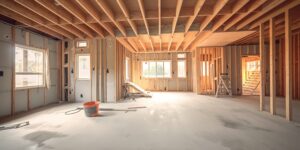Following a wild 2021 in the home building and real estate markets, PWSC assembled “Five Residential Construction Trends for 2022” to kick off the new year. Now more than halfway to 2023, we thought this was a good time to revisit those predictions.
Turns out our crystal ball works well, but some trends even we didn’t anticipate. Here’s a look at where things stand today.
Trend #1: Build-to-Rent Keeps Booming
Bruce McNeilage, CEO of real estate consultant Kinloch Partners, asks an intriguing question. “How do you differentiate between a fad and a trend?” His answer is to watch Wall Street, because they don’t invest in fads. If that is true, build-to-rent is a trend with staying power.
John Burns Real Estate Consulting anticipates more than $50 billion in build-to-rent development investments by the end of 2023. That marks a 67% increase from the year prior. The capital infusion aligns with a big squeeze keeping buyers out of the market.
The median U.S. household income for 2021 was $79,900, a modest 1.8% increase from 2020. During that same time housing prices rose 18.8%. By comparison, single-family rent increased just 12%. Pair that with the fact that less than half of all homebuyers (27.8% for first-time buyers) can put 20% down on a home and build-to-rent offers a significant economic advantage.
Despite the financial implications, single-family rentals also align with a changing mindset that spans generations. These are the starter homes of today. In fact, many millennials and members of Gen Z indicate they plan to live as permanent renters. Even Baby Boomers are buying in as they look toward a maintenance-free lifestyle.
The last four quarters produced 57,000 build-to-rent home starts, a 32.6% gain from the previous year. With investments mounting, expect single-family rentals to continue comprising a greater percentage of all home starts annually.
Trend #2: Shortages and Steep Prices
The current shortfall of houses in the U.S. is approaching 2 million. But that is not a problem fixed anytime soon. According to the National Association of Home Builders, average construction times have doubled since before the pandemic.
Going from four to more than eight months is not because people are requesting vastly different homes. Building materials, appliances, labor, and housing lots remain in short supply. Today more than 90% of builders report shortages, the most since tracking the metric began 30 years ago.
Everything from lumber to garage doors are harder to come by. Materials coming from China to the Port of Los Angeles by container ship took around 50 days before the pandemic. That number is above 100 days today. The war in Ukraine complicates things further. Embargos on Russian oil now are creating asphalt shortages as well.
Not only are materials taking longer to procure, but they cost more too. Inflation hit a 40-year high in June of 9.1%. Housing represents about one-third of the current inflationary pressure.
In our 2022 report, we anticipated a 1.4 million shortage of construction workers and skilled tradespeople. Turns out we underestimated this growing problem. The Home Builders Institute now reports needing 2.2 million new construction workers within the next three years to meet housing demands.
Despite signs of the residential real estate market cooling off, expect housing shortages to persist. Little hope appears on the horizon for supply chain delays and labor shortages to significantly lessen.
Trend #3: Commercial Insurance Uncertainties
Construction market premiums increased in Q1 2022 for the 18th consecutive quarter. COVID-related price hikes have been replaced by the problems listed in trend #2. As housing prices, construction materials costs, and labor wages continue rising, so will insurance premiums. In fact, the double-digit jumps in some lines have failed to cover costs. Moody’s anticipates a 5% increase in homeowner insurance rates and 6.5% for commercial property in 2022. Similar numbers apply to workers compensation.
Cyber and umbrella insurance represent some of the costliest policies to add. Since insurers already consider construction “risky business,” maintaining a favorable loss history and presenting a sound risk mitigation strategy at renewal represent the best ways to push back on premium hikes.
Trend #4: Construction v. Courtroom
Type in “home construction lawsuits 2022” into your browser. The search results will tell you everything you need to know about this trend. Litigation against home builders is alive and well in 2022. Class actions continue to represent a major problem. Our advice for increasing risk reserves this year was a good one.
At the top of our radar are the rising costs surrounding lawsuits in general. Verdicts exceeding $1 million increased nearly 1,000% from 2010 to 2019. Verdicts of $20 million or more grew 300% in 2019. The trend continues today.
Some states are introducing legislation to limit jury awards, but the risk is here to stay. The best defense is a good offense. Consult with your insurance provider to ensure you have the proper coverages in place. PWSC also offers mediation and arbitration services as part of our home warranties to keep cases out of court.
Trend #5: Escalating Customer Expectations
When we wrote our Five Trends report, the median home price was just above $350,000. As of June 2022, that number ballooned to $450,000. At that price, you can bet buyers want more for their money.
Additional space stands as most important to buyers in 2022. Updated features and open floor plans come in second. Now ranking third is low-maintenance features.
Today’s buyers lack the expendable funds to worry about post-purchase home costs. Therefore, saving money on maintenance offers a strong selling point. Buyers prefer turn-key properties, even if they must wait several months for construction.
The same is true for build-to-rent. Nearly 12% of renters vacate a property because of maintenance issues. Even on the single-family rental side, people want move-in-ready properties void of on-going maintenance hassles.
Plan for the Future with PWSC
PWSC tracks the trends most important to the home construction and real estate markets. By staying ahead of what’s next, we can offer unique home warranty protections that address and mitigate risk in an ever-evolving industry. In fact, PWSC stands as the first provider offering structural home warranties for build-to-rent properties in addition to best-in-class home builder warranties. Learn more about our unique home warranty services and stay tuned as we make our trend predictions for 2023.




